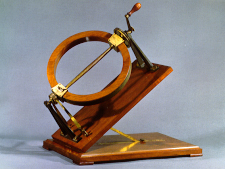
42 x 36.1 x 58
Wood, copper and brass
CAT. 1878 : 512
Disco de Delezenne.
Delezenne disc.
After the first studies on electromagnetic induction, Faraday presented a report on his latest work on December 21, 1831. This concerned the induction of an electrical current in a suitably coiled conductor, using the Earth's magnetic field.
In one of his experiments he used a coil of copper wire, inside which he placed a cylindrical bar of soft iron. This bar was first made red hot and slowly cooled to eliminate any remaining magnetism. When the coil was connected to a galvanometer and turned in direction of the Earth's magnetic field, the needle was not deflected at all while the instrument was at rest. However, if the coil and iron bar were rotated rapidly through 180 degrees on the magnetic meridian plane, the galvanometer showed a significant deflection.
Based on this research work, Delezenne designed an instrument made from a ring, around which a copper wire was wounded, which could rotate on an axis of its diameter. This rotational axis should be aligned with the Earth's magnetic meridian at an inclination, relative to the horizontal, such that the axis was perpendicular to the final direction taken by the magnetic inclination needle.
Once the terminal of the copper wire coil is connected to a sufficiently sensitive galvanometer, an induced current can be detected in the coil, when the ring is rotated on the axis. The direction of the induced electrical current depends on the direction of rotation of the ring.
The model in the Gabinete de Física is dated 1864.
Faraday, Michael, Experimental Researches in Electricity, London, 1838, pp. 42-75.
Daguin, Pierre Adolphe, Traité Élémentaire de Physique Théorique et Expérimentale, Paris, 1878, Vol. III, n.º 2192.
Ganot, A., Traité Élémentaire de Physique, 19th edition, Paris, 1884, Fig. 894.